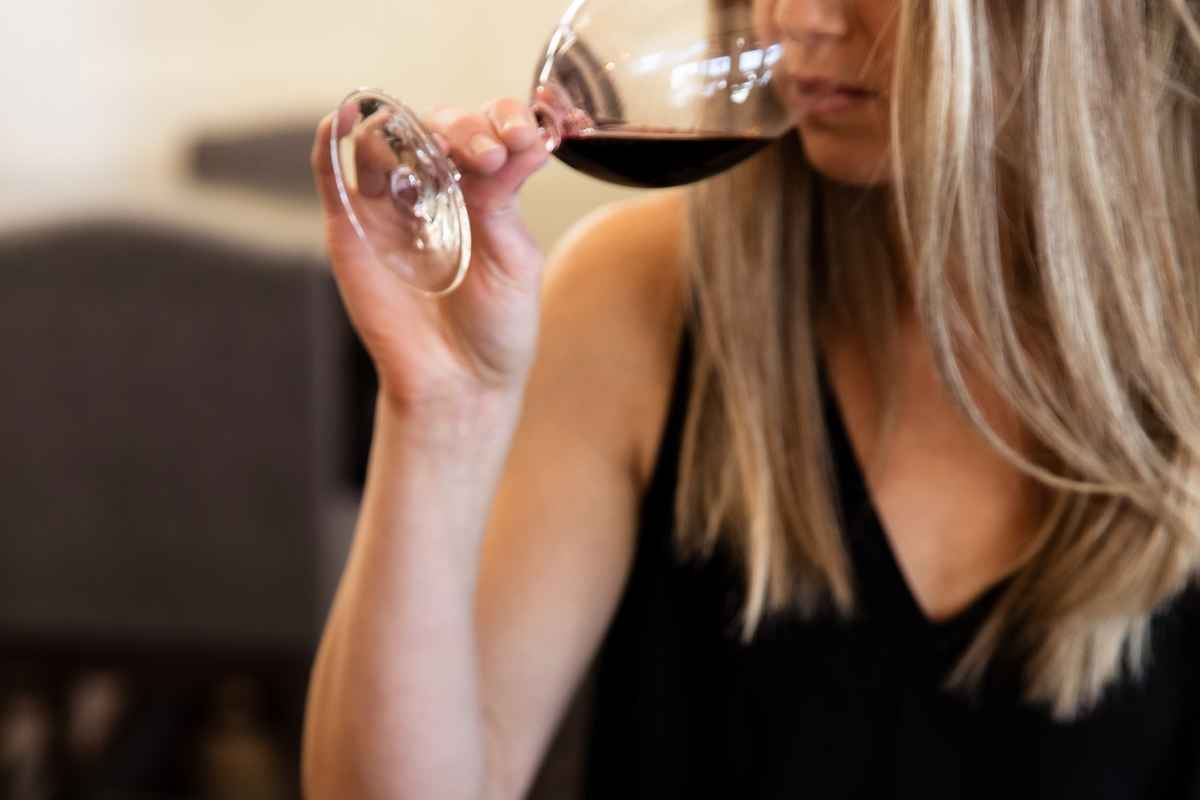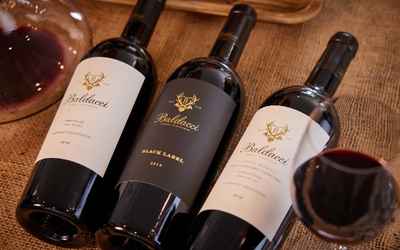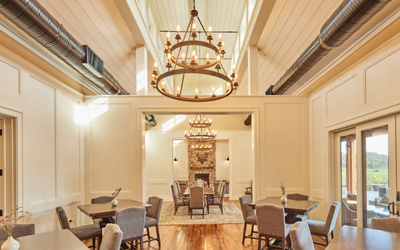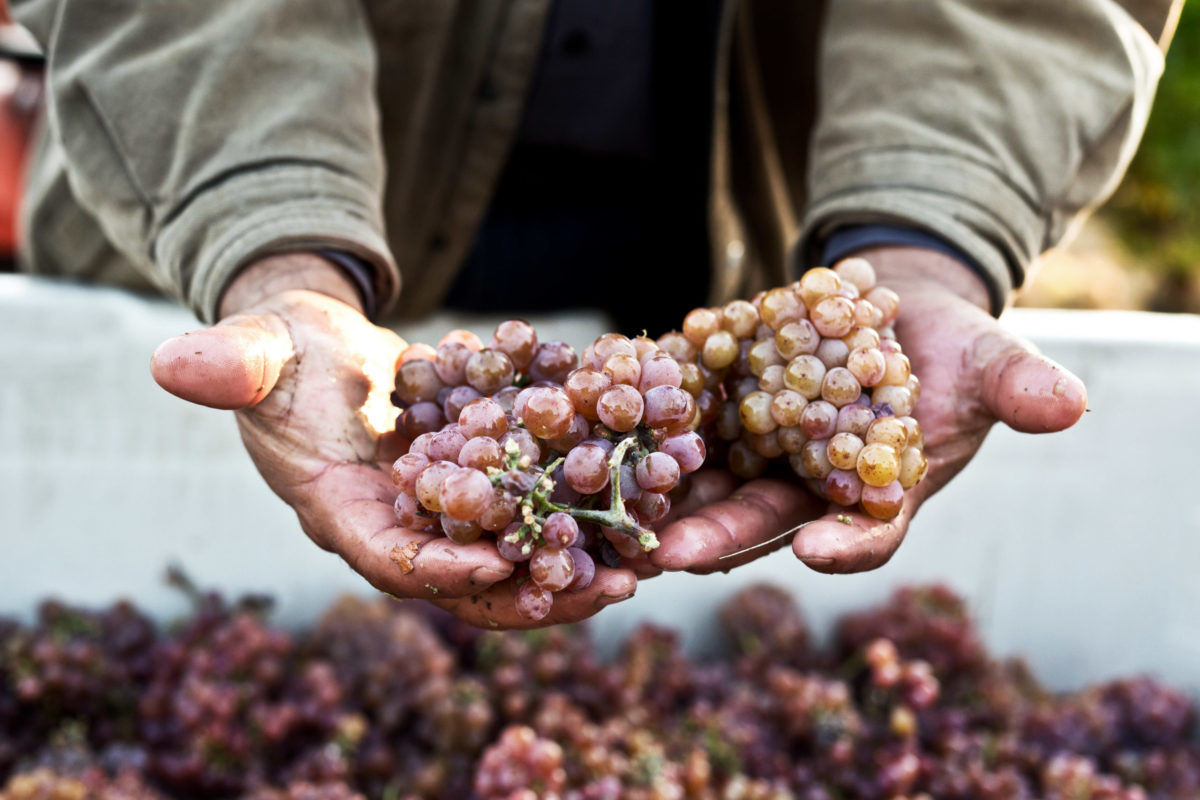
Now that we’ve learned about the first “S”, Sight, and what a wine’s appearance can tell you, it’s time to move on to the next two steps, Swirl and Smell. This post is all about the aromas in wine – where they come from, how to describe them, and what they indicate about the wine in your glass. Truth be told, this is one of my favorite parts of the entire tasting process, and I think you’ll see why!
Part 2 – Swirl & Smell: Evaluating the Aromas of Wine
I know, I know. You’re probably thinking, “Can we just taste the wine already?” But consider this: Much of what we taste, flavor-wise, is actually from our sense of smell, through a process called retronasal olfaction. Just think back to a time when you’ve been congested with a cold or allergies and even the most flavorful foods taste bland. What does this mean when it comes to tasting wine? Our nose plays a critical role in wine evaluation and appreciation, maybe even more so than our mouth.
Let’s get started…
Step 1: Smell
Start by taking a few short sniffs of the wine with your nose about an inch or so above the rim of the glass. Your sense of smell can easily become fatigued if you smell too rapidly or too deeply, and the alcohol vapors in the glass can irritate your nose if you sniff too close to the wine’s surface. As you go through the following steps, continue to take short sniffs of the wine to evaluate the aromas at each stage.
Step 2: Swirl
Hold the glass by the stem and swirl the wine in a circular motion for 5-10 seconds. If you need some practice with your swirling technique, start with the glass on a flat surface to get familiar with the motion. Swirling introduces more oxygen into the wine, helping to release the aromas. In other words, giving your nose more to smell.
Step 3: Is the wine clean or faulty?
As delicious as wine is, every now and then, you may end up with a faulty bottle. Below are some flaws that can be found in wine, and how to detect them.
Cork Taint
If a wine suffers from cork taint (often described as “corked”), it is affected by a compound called trichloroanisole, or TCA for short. This makes the wine smell musty – think wet cardboard or wet dog. The term “cork taint” is used because the compound often originates in the cork itself, but it can also be caused by contaminated barrels or winery equipment.
This wine flaw doesn’t cause any physical damage to the cork itself; if the cork disintegrates while opening the bottle, this could be a sign of improper storage conditions, an older bottle, or poor opening technique. There’s no grey area when it comes to cork taint, so if you happen to open a corked bottle, contact the retailer for a refund.
Oxidation
A wine sealed with a cork will be exposed to small amounts of oxygen over time, which can help quality wines age gracefully and develop additional complexity with bottle age. However, if a wine is aged too long or in poor conditions (such as standing upright), excessive oxygen exposure will cause a loss of color, aroma, and flavor, leading to less expressive aromas and flavors that are more cooked and dried rather than fresh.
Volatile Acidity
Volatile Acidity, or VA for short, is caused by the presence of acetic acid in the wine. This can be created during the fermentation process and can lead to vinegar-like aromas and flavors in the wine. Volatile acidity is related to another flaw caused by ethyl acetate (EA), which imparts an aroma of acetone, commonly found in nail polish remover. EA can actually be positive in small quantities, as it can help to lift a wine’s aromas.
Brettanomyces
Brettanomyces, or “Brett” for short, is caused by a yeast that can impart a variety of aromas, from cloves and spice to Band-Aids and horse manure. Individual sensitivities and preferences vary; some consider Brett a fault no matter what, whereas others enjoy it in small quantities.
Step 4: How intense are the aromas?
When first sniffing the wine, think about the intensity of the aromas. Are they flying out of the glass, maybe even without actively sniffing it, or are they subtle? We use a scale of delicate, moderate, and powerful when it comes to aroma intensity. A greater intensity of aromas can be a mark of wine quality, but keep in mind that some wines are intentionally crafted to be more delicate and subtle in aroma and flavor.
Step 5: What are the fruit aromas in the wine?
Now we’re on to describing the distinct aromas we find in the wine, starting with fruit aromas. While wine is, at the end of the day, made from grapes, most wines will not smell or taste distinctly grape-y. There are several reasons for this.
First, wine grapes are not your average table grapes. Each grape variety has unique characteristics, included aroma and flavor compounds, that can be detected in the finished wine. Syrah, for example, has black pepper aromas from a compound called rotundone, which can sometimes be detected in the grapes or juice before fermentation. Grapes in the Bordeaux family, such as Cabernet Sauvignon and Sauvignon Blanc, can express green aromas and flavors such as bell pepper, jalapeño, and grass, which are caused by a group of compounds called pyrazines.
Fun Fact: One out of every five people lacks the ability to smell the compound rotundone, which is also responsible for giving black pepper its distinctive aroma and flavor. That’s 20% of the population!
Second, during the fermentation process, many new aroma compounds are created, some from the grapes themselves, and others from the interaction of the yeasts and different acids that are present. This last category, known as “esters”, are sensed as fruity aromas like apple, pineapple, and banana.
Third, post-fermentation winemaking steps, such as malolactic fermentation or barrel aging, can add new aromas to the wine and change the existing aromas. More on these two processes in the next step!
Wine can express many different aromas – hundreds, even! A good rule of thumb when you begin identifying aromas is to choose three fruit aromas. Think about broad categories first, such as citrus or tropical fruit. Once you’ve decided the wine smells citrus-y, you can begin to think about whether it’s more of a lemon or lime quality, or maybe even orange or tangerine. No aromas are mutually exclusive, so feel free to name more if you’d like! Below are common aromas found in both white and red wines.
White Wines
Citrus Fruit: Lemon, lime, orange, grapefruit, tangerine
Orchard Fruit: Green, red, and yellow apple and pear
Stone Fruit: Peach, nectarine, apricot
Tropical fruit: Papaya, mango, pineapple, passion fruit, banana, guava
Melon: Cantaloupe, honeydew, watermelon
Red Wines
Red Fruit: Cherry, raspberry, red plum, cranberry, strawberry, pomegranate
Black Fruit: Blackberry, black cherry, black plum, blackcurrant
Blue Fruit: Blueberry, boysenberry
Step 6: What are the non-fruit aromas in the wine?
As briefly mentioned above, non-fruit aromas can come from post-fermentation winemaking practices, (such as malolactic fermentation and oak barrel aging), from bottle aging, from the grape variety, or from other sources.
What is malolactic fermentation?
Malolactic fermentation is a process carried out in almost all red wines – and some white wines. The process converts tart, green apple-like malic acid into softer, creamier lactic acid (think Greek yogurt or sour cream). During the process, a compound called diacetyl can be created. Diacetyl is the flavoring used for movie theater popcorn butter – and can contribute the same buttery aroma and flavor to white wines like Chardonnay.
Fun fact: The threshold for us to detect diacetyl in red wines is much higher – hence why red wines don’t smell and taste buttery!
What aromas are derived from oak barrels?
The wood used for oak barrels contains different aroma compounds, known as lactones. Depending on the origin of the oak and the barrel production methods, these can impart flavors like coconut, vanilla, and spices to the wine.
Fun fact: Barrels can be used more than once, but with increased use, the aromas imparted to the wine decrease. After about four uses, the barrel is considered neutral.
As with fruit aromas, see if you can name at least three non-fruit aromas. Below are some examples to get you started.
Earthy aromas: Forest floor, mushroom, potting soil, compost
Mineral aromas: Wet stones, chalk, slate, flint, limestone
Oaky aromas: Baking spices (cinnamon, clove, nutmeg), vanilla, cedar, toast, smoke, coffee
Floral aromas: White flowers (jasmine, honeysuckle), roses, purple flowers (violet, lilac)
Herbal aromas: Grass, dried herbs (oregano, sage, thyme)
Vegetal aromas: Bell pepper, jalapeño, asparagus
And this is just the beginning! The good news is, at the end of the day, if you smell it in the wine, it’s valid.
How to improve your sense of smell
Practice, practice, practice! I constantly smell flowers and plants while walking in my neighborhood (often to my fiancé’s chagrin). Or, stop by your local farmer’s market and start smelling all of the wonderful fruit and vegetable aromas from the abundance of fresh produce. You can also practice right at home with a friend or partner. Each person chooses 10 or so items from the fridge, spice rack, and pantry. Take turns blindfolding each other and “blind-smelling” the items. You’ll be surprised at how tricky it is to identify aromas without the visual cues. But since this is exactly what we are attempting when we taste wine, this will only improve your tasting skills!
If you enjoyed this post, make sure to keep an eye out for the next post in the series, “Sip”, where we’ll cover everything related to the flavors and structure of wine. Until next time!




